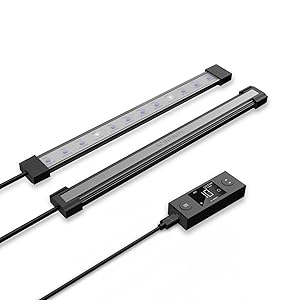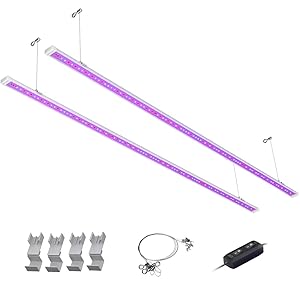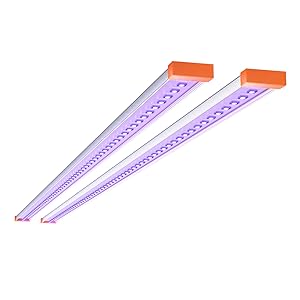UV (ultraviolet) light is electromagnetic radiation that sits just outside the visible light spectrum for human eyes. It’s divided into three types: UVA, UVB, and UVC. UVA has the longest wavelengths and is the least harmful, while UVC has the shortest and most harmful wavelengths.
Controlling UV light for indoor plants is manageable with the right equipment (PAR meter). Monitor the intensity and duration of the UV light exposure to avoid damaging your plants.
Excess UV light causes harm to plants, resulting in sunburn, cellular damage, and impaired growth. A lack of UV light leads to slower growth and less robust plants, as UV light stimulates plant defenses and enhances growth.
To choose UV lights, consider factors like the specific needs of your plants, the size of your growing space, and the type of UV light (UVA, UVB, or UVC light). Look for lights with adjustable intensity levels and a good UVA and UVB light balance.
To use UV light, expose your plants to it gradually, starting with short periods and slowly increasing the duration over time. Monitor your plants closely for any signs of stress or damage.
Table of Contents
- What is UV Light?
- How Does UV-A and UV-B Light Affect Plants?
- 5 Best UV Light for Indoor Plants
- 1. Hyphotonflux UV-A LED Grow Light – Best low-heat UV spectrum
- 2. AC Infinity IONBEAM U2, Targeted Spectrum UV LED Grow Light Bars – Best modern grow lights for plants
- 3. MARS HYDRO UR45 45W UV & IR Supplement Light Bars for Led Grow Lights – Best supplementary grow lights for plants
- 4. Spider Farmer UV30 UV Supplemental LED Grow Light – Best grow light for yield
- 5. Spider Farmer UVR40 UV & IR Supplemental Lighting SF4000 LED Grow Light – Best energy-efficient UV grow lights
- How do you choose the best UV light for plants?
- How do you use UV light to grow indoor plants?
What is UV Light?
Ultraviolet (UV) light is a type of electromagnetic radiation that is invisible to the human eye. It falls in the spectrum between visible light and X-rays, with wavelengths ranging from 10 nanometers (nm) to 400 nm.
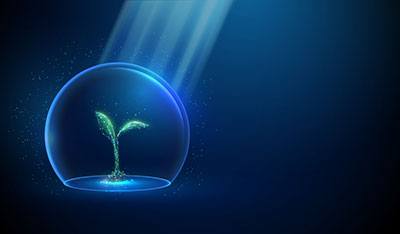
UV light and grow lights play crucial roles in plant growth, as they promote light spectrum to support photosynthesis and assure full plant growth and development in all three stages: seedlings, vegetative, and flowering. The lights cover the entire spectrum of light plants require – from UV to far-red.
Though excessive UV light can be harmful (damaging DNA, proteins, etc.), moderate amounts promote plant health. It helps produce antioxidants, which protect the plant against harmful organisms. Also, it aids in creating flavonoids that contribute to the plant’s color, taste, and resistance to disease.
UV light is classified into three types based on their wavelengths: UV-A, UV-B, and UV-C.
- UV-A: With a wavelength range of 315-400 nm, UV-A light is the least harmful and is commonly used in black lights. It’s also the most abundant UV light source on Earth’s surface (98.7%). It’s not harmful to plants, animals, or humans.
- UV-B: UV-B ultraviolet light ranges from 280-315 nm. While partially filtered by the atmosphere, some of this light reaches the Earth’s surface and can cause sunburns in plants and humans (1.3% remaining ultraviolet light). The B type ultraviolet light harms humans, plants, and animals as it causes skin cancer, damaging proteins, lipids, membranes, and DNA. The ultraviolet light requires sun protection for humans and protective sunglasses for grow rooms.
- UV-C: The C type ultraviolet light is the most dangerous form of UV light with a range of 100-280 nm. Fortunately, nearly all of it is absorbed by the Earth’s atmosphere. It’s used artificially for its germicidal properties in water treatment and air purification. It’s the most harmful UV light for humans, plants, and animals, as it causes skin cancer, lesions, and burns. There is no protection from the UV light – C type.
UV light, particularly UV-A, stimulates plant growth by affecting plant pigments and encouraging the production of protective compounds like flavonoids. However, too much UV light (especially UV-B and UV-C) harms many plants, leading to damage or slower growth.
IR light is less energetic than visible light and UV light, primarily experienced as heat by humans and plants. For plants, IR light aids cell division and growth, particularly in the stems and leaves. It’s also crucial in opening stomata, small pores used for gas exchange.
While both UV and IR light have roles to play, the most essential light for plants is within the visible spectrum (400-700 nm), where photosynthesis primarily occurs. The light spectrum includes the blue and red wavelengths that are key for processes such as chlorophyll absorption.
UV and IR light are often discussed together because they represent the invisible portions of the electromagnetic spectrum that are just beyond the visible light range that humans can see. They’re also both components of sunlight and thus can affect plant growth in outdoor settings.
When discussing artificial lighting for plants, such as in greenhouses or indoor gardens, UV and IR lights are often included in the “targeted spectrum” of light provided by grow lights. This spectrum seeks to mimic the beneficial aspects of natural sunlight as closely as possible, including visible light and UV and IR wavelengths. The aim is to provide plants with the optimal light conditions for photosynthesis and other growth processes, maximizing their health and productivity.
How Does UV-A and UV-B Light Affect Plants?
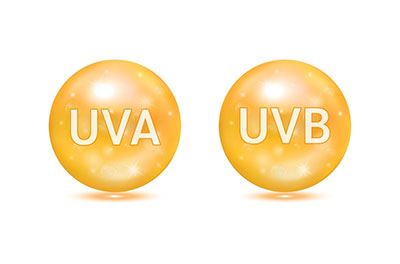
Plants respond to both A and B UV rays in increased production of antioxidants/ flavonoids and other natural sunscreen compounds in photormophonogenesis.
Photomorphogenesis is a developmental process in which the incident light determines the plant’s growth.
During this process, the pattern of plant growth is controlled by the spectrum of light available to the plant as energy, as the study named “Regulation of Photomorphogenic Development by Plant Phytochromes” at the Chonnam National University in Korea explains. However, the A and B UV lights have both positive and negative effects on indoor plants, as listed below.
Benefits of A and B UV Lights on Indoor Plants
These are the 7 main beneficial effects the A and B UV lights cause to grow plants:
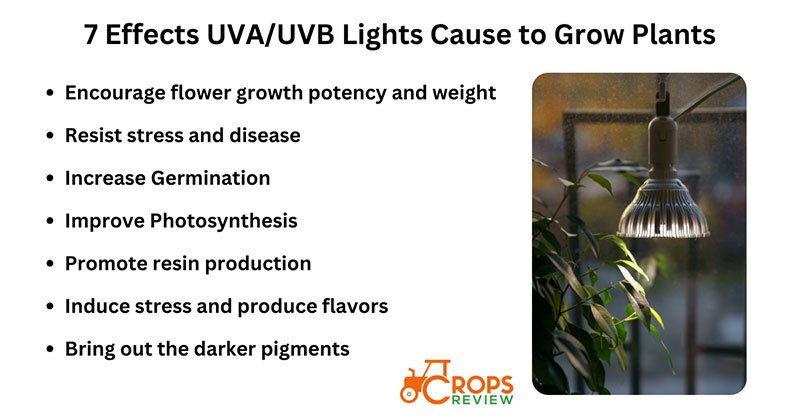
- Encourage Flower Quality, Potency, & Weight: UV light for plants stimulates the production of secondary metabolites, which improve flower quality and potency. For instance, in cannabis plants, UV-B exposure has been linked to increased THC content, according to scientific research name “Cannabis Inflorescence Yield and Cannabinoid Concentration Are Not Increased With Exposure to Short-Wavelength Ultraviolet-B Radiation” at the School of Environmental Sciences, University of Guelph, Canada.
- Resistance To Stress & Disease: UV light for plants enhances a plant’s resistance to stress and disease. The production of flavonoids and other protective compounds increases with UV exposure and reduces plant stress.
- Germination: Certain seeds (Thuja and Picea) require UV light for germination. The UV light breaks down the inhibitors in the seed coat, allowing the seed to germinate.
- Photosynthesis: Although photosynthesis primarily uses visible light and the full light spectrum, studies titled “Short-Term Ultraviolet (UV)-A Light-Emitting Diode (LED) Radiation Improves Biomass and Bioactive Compounds of Kale” suggest that UV-A light may also contribute to photosynthesis.
- Resin Production: UV-B light stimulates resin production in some plants, like pine trees. The stimulation increases the plant’s defenses against herbivores and pathogens.
- Induce Stress and Produce Flavor: UV-B radiation induces mild plant stress, producing more flavorful and nutritious compounds.
- Bring Out the Darker Pigments: UV light stimulates the production of anthocyanins, which give plants their red, purple, or blue hues. The process enhances the aesthetic appeal of certain ornamental plants (cacti, begonias, orchids, ferns).
Harmful Effects of UV Light on Indoor Plants
Listed below are the 4 main negative effects that UV light has on plants
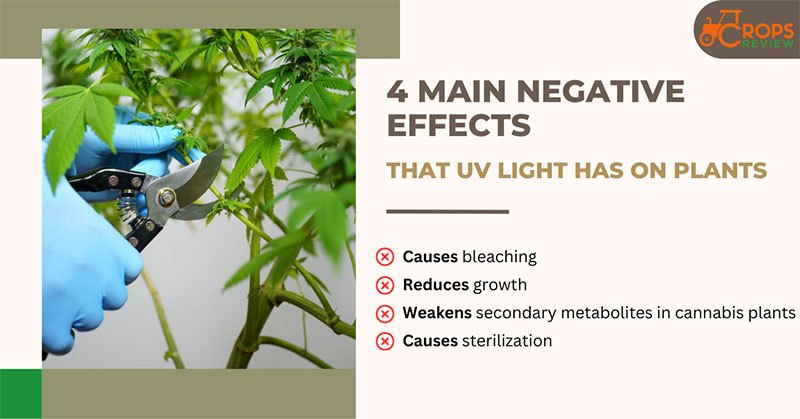
- Causes bleaching: Excessive UV-B light sources cause bleaching in plants, damaging chlorophyll and impairing photosynthesis, as the Max Planck Institute explains in research “Sun protection for plants.”
- Reduces Growth: High levels of UV-B radiation inhibit plant growth by damaging plant tissues and impeding cell division.
- Weakens Secondary Metabolites in Cannabis Plants: While moderate UV-B light increases THC content in cannabis, excessive UV-B can reduce CBD content, another important cannabinoid, according to the Hindu University, India, in research “Untangling the UV-B radiation-induced transcriptional network regulating plant morphogenesis and secondary metabolite production.”
- Sterilization: Too much UV-C light is sterilizing, killing plant tissues and potentially the entire plant.
5 Best UV Light for Indoor Plants
Listed below are the 5 best UV lights for your growing plants. Read the reviews and check their advantages and disadvantages to choose the most suitable grow light for your growing needs.
1. Hyphotonflux UV-A LED Grow Light – Best low-heat UV spectrum
The Hyphotonflux UV-A LED Grow Light provides a full spectrum of light that is specifically tailored for plant growth. It emits UV-A light that plants require. The 30W power ensures your plants receive enough plants UV light, even in a larger indoor garden.
The UV light supports optimal photosynthesis in all three stages of growth and full germination. The less heat also doesn’t damage the plant’s DNA, keeping them safe. Low heat emission is ideal for professional and commercial growers as UV lighting cannot cause plant burns and bleaching in growing plants.
The two-pack configuration offers excellent value for money, providing double the coverage for a reasonable price. The two pack UV lighting uses 80 grow lights in daisy-chained mode, and they offer 0-100% dimmable features for optimal UV spectrum and proper light standards.
The lights are easy to install and have a robust design that holds up well over time.
The artificial lights use plug-and-play connectors for quick setup and suspend hooks for ease of use.
The lifespan is over 40,000 hours, so the UVA light is durable and solid for longer working hours.
We rated this UV light at 4.5/5 due to package issues (some parts come damaged), and users must replace them, causing more costs. The average price matches the quality, but the UVA light is not affordable for all customers.
Pros: ample grow light spectrum, robust design, easy to install
Cons: pricey for beginners
2. AC Infinity IONBEAM U2, Targeted Spectrum UV LED Grow Light Bars – Best modern grow lights for plants
The AC Infinity IONBEAM U2, Targeted Spectrum UV LED Grow Light Bars offer targeted spectrum lighting, which benefits plant growth. The UV spectrum grow light emits both UVA and UVB light to stimulate plant defense mechanisms, improve flavor and color, and increase the production of essential oils and antioxidants in plants.
The LED lights are also ideal for flowering plants, as they offer the optimal LED grow light spectrum for plants growing mechanisms, between 365nm and 395nm. The plant grow room lights create a natural environment for optimal photosynthesis and full plant development.
The LED lights are energy-efficient, reducing the cost of operation over time, allowing you to use LED lights for an extended period, and ensuring the plants get adequate exposure to grow fully.
The slim design of the bars allows for versatile placement, making it easy to fit them into any indoor garden setup. The magnetic frame allows mounting onto the grow tent’s frame or canvas. You can use included steel bars for easier setup.
The dimmable feature is manageable due to the digital controller you can set up and manage to prevent high-intensity light that destroys a plant’s growth.
The AC Infinity grow light is rated 4.4/5 since the grow lights have issues with the timer control. You must manually manage the light-emitting diodes and UV wavelengths for the given price.
Pros: energy-efficient, full spectrum for all growing stages, easy to install and use
Cons: timer malfunctions, short cable for installation
3. MARS HYDRO UR45 45W UV & IR Supplement Light Bars for Led Grow Lights – Best supplementary grow lights for plants
The UR45 supplementary LED grow light bars include 2 bars with 192 LED diodes, delivering a total power output of 45W. The grow light bars provide UV and IR light supplementation for indoor plants grown under white full-spectrum LED grow lights above 730 watts in a 4X4ft area.
With standard grow lights, the UV grow light (365-420nm) emitted from the UR45 supplementary light bars promotes larger leaf growth, thereby significantly boosting plant yield. UV light exposure also enhances the nutritional value of plants and stimulates increased production.
The IR (730-745nm) emitted from the UR45 supplementary light bars interact with far-red light to trigger a shade-avoidance response in plants, speeding up stem growth. IR expedites the transition of plants into the flowering or sleeping stages.
The supplementary grow light bars feature a spectral switch that allows growers to turn ON/OFF the UV or IR light independently or both simultaneously, providing flexibility in supplemental spectrum configuration. The system enables growers to use it as either a UV or IR grow light.
The light bars come with brackets specifically designed for Mars Hydro FC and FC-E LED grow lights and hooks for overhead hanging, making them adaptable to 4×4 grow rooms.
The LED grow light is rated at 4.5/5 by our reviewers due to its lower brightness, so there is insufficient output for seedlings. The average price is not cheap, and the package issues add extra costs to the damaged parts.
Pros: full spectrum for photosynthesis, easy to install with light fixtures
Cons: not so bright, broken parts
4. Spider Farmer UV30 UV Supplemental LED Grow Light – Best grow light for yield
The Spider Farmer UV supplement grow light, boasting premium quality and safety, utilizes 30 watts of power, composed of ultra high-quality UV-A LED diodes in the 365-420 nm spectrum.
The aluminum passive-cooled bars ensure intense light and heat dissipation, and they’re UKCA/ROAS/CE certified for safe use. So it cannot hurt plants or users.
The Spider Farmer UV LED Light Bar set is engineered to provide targeted supplemental blue light, mirroring natural sunlight levels. These UV lamps promote overall plant health, vigorous growth, improved flower development, and increased yield with the red light.
The average life is 50,000 hours, and you can use the bars for prolonged exposure to provide the light the plants require.
Due to the aluminum design, the grow lights cannot damage the frame quickly, and the grow lights last for an extended period.
It’s designed to pair with Spider Farmer SE7000, SE1000W, G860W, and G1000W grow lights, or you can hang it independently as a single fixture. Each fixture is ready to use straight out of the box, requiring no additional wiring.
The Spider Farmer grow lights have a light switch for easy control, making it plug-and-play. The package includes the hardware parts, so you don’t need to purchase them separately for the installation.
We rated it at 4.5/5 due to reduced brightness, and the price is higher for some users.
Pros: quick setup due to fixtures, lightweight and flexible for use, energy-efficient, solid construction
Cons: not so bright, pricey for beginners
5. Spider Farmer UVR40 UV & IR Supplemental Lighting SF4000 LED Grow Light – Best energy-efficient UV grow lights
The Spider Farmer UVR40 grow light incorporates both ultraviolet (UV) and infrared (IR) wavelengths, which can accelerate flowering, resulting in quicker bloom development than non-UV IR supplemental lights.
The grow lights ensure a full spectrum of blue and red light for all growing stages of herbs, flowers, vegetables, cannabis, fruits, microgreens, and leafy greens. These grow lights ensure photosynthesis and energy necessary for healthy development and plant reproduction.
The Light Bar is a plug-and-play device, equipped with hanging brackets and all necessary components included in the box.
The UV IR Supplemental LED Grow Light Bar offers multiple installation options.
The UV grow lights function as an independent lighting source or complement your existing LED Grow Lighting solutions.
LED Grow Lights offer lower operating costs and higher-quality yields by leveraging the latest high-yielding LED technology, specifically Samsung LM301B diodes. These grow lights are highly energy-efficient at 2.7 umol/J, providing potent light output and uniform canopy penetration, leading to maximum yields. Consuming only 450W, the grow lights operate at 50% less power than HPS or other SMD LEDs or Blurple lamps.
The coverage area for vegetative growth is 5 x 5 ft, while for flowering, it’s 4 x 4 ft.
We rated the Spider Farmer UVR40 grow light at 5/5. However, the price is higher, so it’s costly for newbies.
Pros: full spectrum, energy efficiency, ease of use
Cons: pricey
How do you choose the best UV light for plants?
To choose the best UV light for plants, consider light spectrum, light duration, size of the growing area and wattage, and energy efficiency.
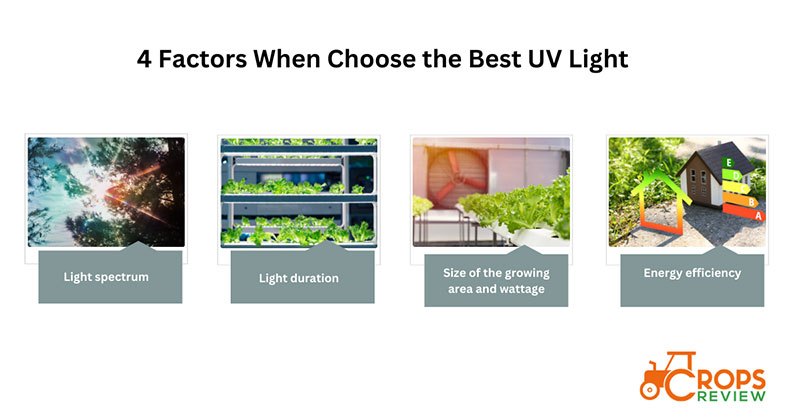
Light spectrum: Choose the UV lights that mimic natural sunlight, as they cover all three stages of plant growth – from seedlings to flowers and fruits.
Light duration: A timer ensures your plants get the right amount of light and darkness. Plants need 10 minutes to two hours of light every day.
Size of the growing area and wattage: For instance, merely 2-3 watts of UV light per square foot of your cultivation area is enough for optimal growth. So, if you have a 4×4 ft growing tent, around 32-48 watts of UV illumination is sufficient to reap the advantages.
Energy efficiency: Choose a UV light that consumes less energy but still provides the necessary light for plant growth. LED lights are often a good choice as they are energy efficient and have a longer lifespan.
How do you use UV light to grow indoor plants?
Consider factors such as PPFD, UV, and IR requirements to use UV light for growing indoor plants.
For the vegetative stage, it’s suggested that your plants receive 16 to 18 hours of light daily for optimum growth and a bountiful harvest. A PPFD of 400-600 µMol/m2/S is recommended during this phase, along with one hour of supplemental UV light each day in the later parts of the vegetative stages.
In the flowering stage, a more natural light cycle of 12 hours of light and 12 hours of darkness is advised. Set your lights at a medium intensity to maximize yield and enhance potency. The suggested PPFD for this stage is between 800-1,000 µMol/m2/S. In the early flowering stages, provide 60 to 90 minutes of supplemental UV light, increasing to 90-120 minutes in the middle of the flowering stage.
In the final 2-3 weeks of the flowering stage, increase the supplemental UV light duration to 120 minutes. Increased supplemental UV light boosts THC levels and overall chemical profiles if you grow cannabis, for example.
Expose your plants to IR light for 30 minutes before turning off the day’s lights. Divide the 30 minutes into three segments: 10 minutes of IR light, 10 minutes off, and then another 10 minutes of IR light (10 – on, 10 – off, 10- on). After all the lights are off, the plants can rest. This IR light routine applies to all plant growth stages except germination.
To utilize IR more effectively in waking up and lulling the plants, turn on the IR for 15 minutes before and after the main lights are turned on and off every day (15m IR – full spectrum main lights – 15m IR). This method has been proven highly effective as it allows the plants to wake up before receiving light, enhancing light absorption efficiency and quickly transitioning to the sleep period for biomass accumulation.
What are the best methods for giving plants UV light?
The best methods for giving plants UV light are to choose the right type of light, ensure proper UV light placement, secure enough light, and take precautionary measures when utilizing lights.
Choose the right type of light: UV lights specifically designed for indoor gardening are available in various grow light types, including LED, fluorescent, and HID (High-Intensity Discharge) bulbs. Among these, LED grow lights are often preferred because they emit less heat and are more energy-efficient.
Place the UV light properly: The UV light should be positioned correctly over your plants. Being too close burns them, while too far away does not provide enough UV radiation. A general rule is to place the light about 6 to 12 inches above the plants.
Secure enough light: During the vegetative stage, plants usually require more light, typically around 16-18 hours daily. As they move into the flowering stage, the light duration is reduced to a 12-hour cycle, as the University of Missouri explains in the article “Lighting Indoor Houseplants.”
Protect yourself: UV light is harmful to humans. Take precautions when using UV lights, such as wearing protective glasses and gloves.
When should you give plants UV light?
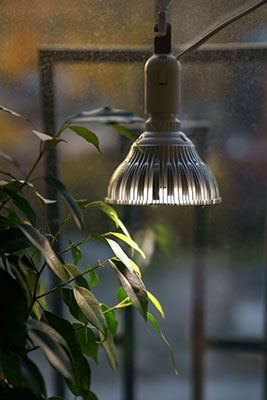
You should give plants UV light when your grow lights do not provide a full light spectrum. The full spectrum ensures all growing stages are optimal – from seedlings to flowers, with green, blue, and red light to promote healthy development and reproduction. The spectrum also ensures full chlorophyll production, helping plants to develop their stems and leaves. Adding UV lights ensures healthy and green vegetation inside the grow room.
How much UV light do plants need?
Plants need only 2-3 watts per square for optimal growth. Too much exposure to UV light causes bleaching, DNA damage, protein damage, and harm to lipids and membranes.
How long should plants be under UV light?
Plants should be up for two hours under UV light exposure every day. Divide the two hours in 2 x 1 stints. You can increase the 1 hour by 15 minutes every 2 days.
What safety precautions must you take for UV lights in the grow room?
The safety precautions you need to take for UV lights in the grow room are to wear protective glasses and never look directly into the light source. The electromagnetic radiation causes irreversible harm to your eyes, such as cataracts, bleeding into the eye, glaucoma, dry eyes, and loss of eyelashes. Also, cover your skin to reduce the risk of skin cancer.
What light is best for plants in a grow tent?
LED grow light is the best for plants in a grow tent. LEDs deliver the precise light spectrum plants require throughout their entire growth cycle. These lights are also the most energy-efficient in a grow tent option.


